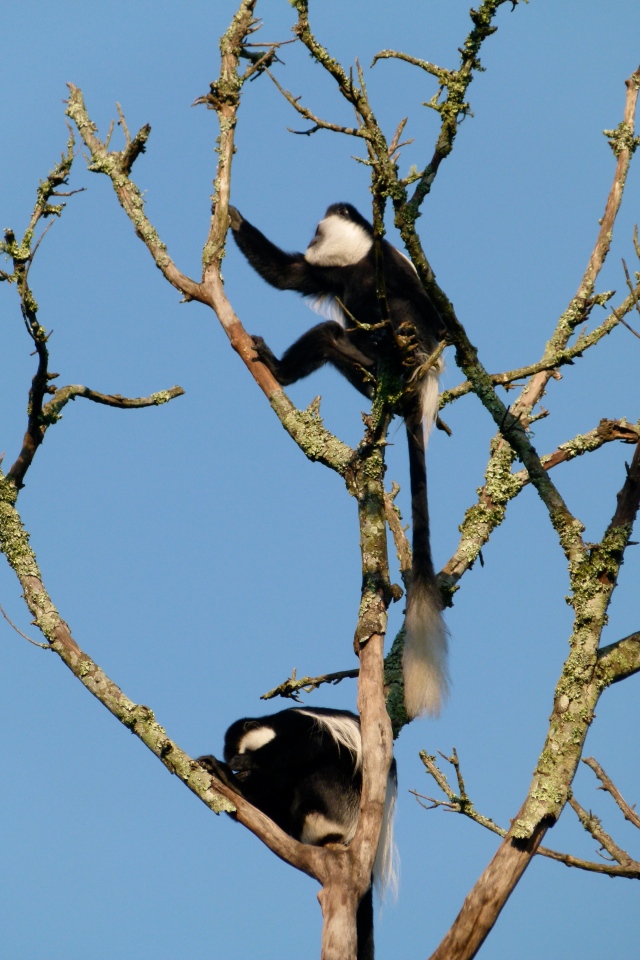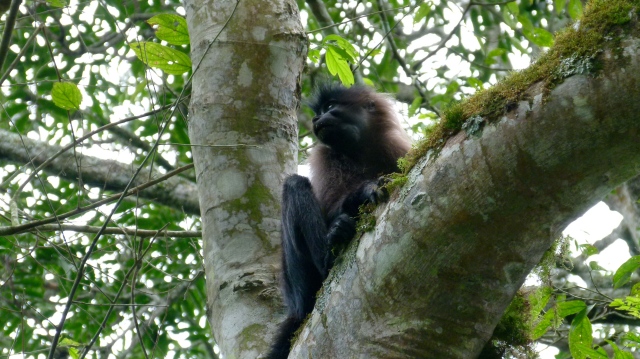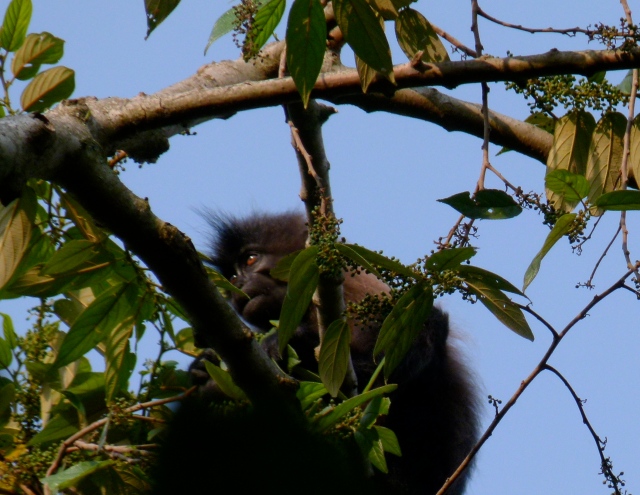Text and pics by Linda-Liisa Veromann

Uganda is a great place for a primatologist – lots of monkeys, e.g. red colobuses, grey-cheeked mangabeys, black and white colobuses (on the picture) etc., but also apes (chimpanzees and gorillas.
My previous supervisors and I have finally published the first article based on the data we collected for my Master’s thesis about mother-infant relationships in gray-cheeked mangabeys (Lophocebus albigena). The article is called “Call rates of mothers change with maternal experience and with infant characteristics in free-ranging gray-cheeked mangabeys: Maternal Calls in Arboreal Mangabeys”.
 Enjoying a meal on the tree – grey-cheeked mangabey (they like to store food in the lower part of their mouth, therefore, the bulge is normal).
Enjoying a meal on the tree – grey-cheeked mangabey (they like to store food in the lower part of their mouth, therefore, the bulge is normal).
As arboreal primates, they have not been as well studied as their grounded counterparts, e.g. baboons and macaques. Living in the canopy adds another dimension to motherhood – trees are usually spatially separated and the primates can go about their days in great heights, so the infants have to be carried from tree to tree and have a more acute possibility of falling to their ends. How is this connected to maternal vocalizations? Well, the answer is two-sided and similarly, the vocalizations have two peaks in the time the mothers are raising the infants. Firstly, there is a peak in vocalizations in the first month of the infant’s life as monkeys can be mean to, but also help each other. Thus, this peak is thought to decrease possible aggressive reactions and to facilitate allomothering, for example other group members carrying the infant from tree to tree as the group moves. Secondly, monkey babies are still babies, i.e. they are more and more curious and somewhat mischievous as they grow up (at the time of weaning), so the mothers need to vocalize to keep the infant from going too far, getting into trouble (falling!), but also to maintain overall socio-spatial cohesion. Furthermore, there was a difference between how much mothers used contact calls depending on the sex of their offspring. Females stay in their natal group while the males migrate, so this can be necessary to build a strong bond in the matriarchy. Interestingly, it has been found that mothers speak more to their daughters in humans as well. We also found that more experienced and older mothers are more relaxed in raising their offspring, so these furry primates are more like us that may be thought at first glance. Additionally, this research shows that the vocalizations of monkeys can be a lot more nuanced and meaningful than previously thought.
Citation: Arlet, M. E., Veromann, L. L., Mänd, R., & Lemasson, A. (2016). Call rates of mothers change with maternal experience and with infant characteristics in free‐ranging gray‐cheeked mangabeys. American journal of primatology, DOI: 10.1002/ajp.22568 (link to full text)
 Living in the canopy keeps them protected from several ground-dwelling predators, but makes it harder for researchers to collect data. That is why most non-human and non-ape primatological studies are about terrestrial monkeys like baboons, macaques, geladas etc.
Living in the canopy keeps them protected from several ground-dwelling predators, but makes it harder for researchers to collect data. That is why most non-human and non-ape primatological studies are about terrestrial monkeys like baboons, macaques, geladas etc.
Abstract:
Studies have shown that becoming a mother triggers important social changes within females, according to both social experience and infant characteristics, showing different maternal concerns. But how this impacts call usage has been far less studied. Based on 6 months of observations of five free-ranging groups of gray-cheeked mangabeys, we investigated variations in the production of three call types (contact, excitement, and alarm calls) in 29 females of different ages, dominance ranks, and infant rearing experiences: 15 females with infants of different ages and sexes, and 14 females without infants. We found that in females with infants, both maternal and infant characteristics influenced call production in a call type-dependent way. Females produced contact calls at a higher rate during the first month of infant age and after weaning when infants start to move away. Mothers of daughters produced more contact calls than mothers of sons. More excitement calls were recorded for first-time and young mothers and for females with young infants, while alarm call rates were not influenced by any of these factors. Increased mother-infant spatial separation enhanced only contact and excitement call rates. Finally, we found that females with infants vocalized much more than females without infants. Our results contribute to the current debate about the social factors responsible for the flexibility of call usage in nonhuman primates and open new lines for research on mothering behavior in forest-dwelling species.
